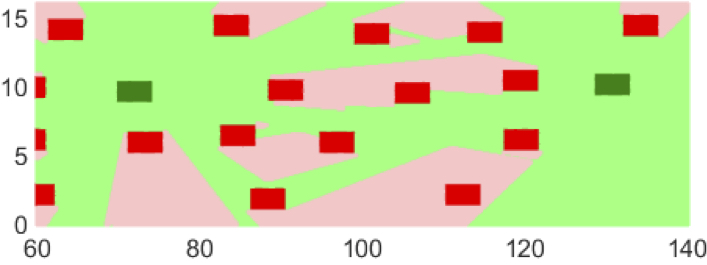
Visibility and Interactive Information Sharing in Collaborative Sensing Systems
Investigators:
Gustavo de Veciana (ECE, UT Austin),
and Haris Vikalo (ECE, UT Austin)
Students and Participants :
Ph.D students Jean Rahal and A. Hashemi ; 12 undergraduate research project particpants. Additional collaboration with researchers at
Toyota, Takayuki Shimzu and Honsheng Lu.
Support: This project is supported by the
National Science Foundation Award (ECC-1809327)
Goal:
Self-driving vehicles and mobile robots have the potential to deliver transformative technological and societal changes. In order to make autonomous decisions, nodes need to have a reasonable degree of situational awareness achieved through recognition and tracking of entities in dynamic environments. This may not be possible in partially occluded environments, where individual nodes may have limited visibility, unless nodes participate in collaborative sensing, i.e., share sensed information. Sharing raw/processed real-time sensing data with centralized resources in the cloud or at the network edge poses potentially high communication/computational burdens, particular in safety critical settings requiring low latency. This motivates the need to study distributed collaborative sensing frameworks leveraging powerful algorithms for tracking and deep learning models for reliable recognition/classification tasks. Of particular interest is a characterization of what collaborating sensors can ``see'' in occluded environments and how one should realize information sharing in resource constrained settings to fairly optimize what nodes ``know'', i.e., their situational awareness. The proposed research effort will advance the state-of-the-art in collaborative sensing systems which are expected to benefit the field and society more broadly, through planned efforts in education innovation, achieving diversity, engaging the community and industry, and disseminating results to a wider public.
This proposal centers on the study of collaborative sensing in obstructed/dynamic environments, such as might be used to enable self-driving vehicles and autonomous robots. The central challenge is to achieve an unprecedented level of real-time situational awareness based on distributed sensing resources in a possibly communication and/or computationally constrained setting. The proposed research integrates three research thrusts.
- The first is the advancement of the fundamental understanding what is visible to sets of distributed sensing units in stochastic environments. This work will leverage stochastic geometric models and analysis to provide robust quantitative performance assessment of `visibility' for typical random environments. The performance limits determined in this research thrust will inform what a distributed system can ``know" in resource constrained settings.
- The second thrust is the development of fundamental underpinnings of distributed collaborative sensing with a focus on the optimization of interactive information sharing and/or adaptation to changing environmental contexts so as to jointly maximize situational awareness amongst autonomous yet collaborating nodes. We will provide new approaches driven by structural properties of the optimization problems (e.g., submodularity) and interactive information sharing protocols to facilitate distributed object recognition and tracking.
- The third thrust is the development of a scaled-down platform for controlled and reproducible experimentation of alternative collaborative sensing system designs. The last thrust is not only geared at providing platform to advance the research but is also an activity to engage a substantial number of undergraduates and a springboard to our educational efforts.
Broader impact and activities
- G. de Veciana presented at IEEE ICC and IEEE WIOPT RAWNET Workshop
- G. de Veciana and H. Vikalo supervised 12 undergraduate honors research/design projects focused on programable obstacle environment platform and real time collaborative sensing.
Publications to date
Submodular observation selection and information gathering for quadratic models.
A. Hashemi, M. Ghasemi, H. Vikalo and U. Topcu
2019 International Conference on Machine Learning (ICML),
Long Beach, CA, June 10-15, 2019.
On submodularity of quadratic observation selection in constrained networked sensing systems.
M. Ghasemi, A. Hashemi, U. Topcu and H. Vikalo
The 2019 American Control Conference (ACC),
Philadelphia, PA, July 10-12, 2019.
Near-optimal distributed estimation for a network of sensing units operating under communication constraints.
A. Hashemi, O. F. Kilic, and H. Vikalo
57th IEEE Conference on Decision and Control (CDC),
Miami Beach, FL, December 17-19, 2018.
Randomized greedy sensor selection: Leveraging weak submodularity.
A. Hashemi, M. Ghasemi, H. Vikalo and U. Topcu
IEEE Transcations on Automatic Control,
(submitted), 2019.
Evolutionary subspace clustering: Discovering structure in self-expressive time-series data.
A. Hashemi and H. Vikalo
IEEE International Conference on Acoustics, Speech and Signal Processing (ICASSP),
Brighton, UK, May 12-17, 2019.
Evolutionary self-expressive models for subspace clustering,
A. Hashemi and H. Vikalo
IEEE Journal of Selected Topics in Signal Processing, Special Issue on Data Science: Robust Subspace Learning and Tracking,
vol. 12, no. 6, December 2018, pp. 1534-1546.
Performance and scaling of collaborative sensing and networking for automated driving applications.
Y. Wang, G. de Veciana, T. Shimizu, and H. Lu
In Proc. IEEE ICC Workshop 5G and Cooperative Autonomous Driving, pages 1-6,May 2018.
Optimized Networked Situational Awareness,
J. Rahal, G. de Veciana, T. Shimizu, and H. Lu
IEEE WiOPT RAWNET Workshop pages 1-8, 2019.
Optimizing timely coverage in communication constrained collaborative sensing systems.
J. Rahal, G. de Veciana, T. Shimizu and H.Lu. In Proc. IEEE WIOPT pages 1-10, June 2020.
Service placement for real-time applications: Rate-adaptation and load-balancing at the network edge.
S. Kassir, G. de Veciana, N. Wang, X. Wang, and P. Palacharla.
In Proc. 6th IEEE International Conference on Edge Computing and Scalable Cloud (EdgeCom),
pages 1-9, August 2020.